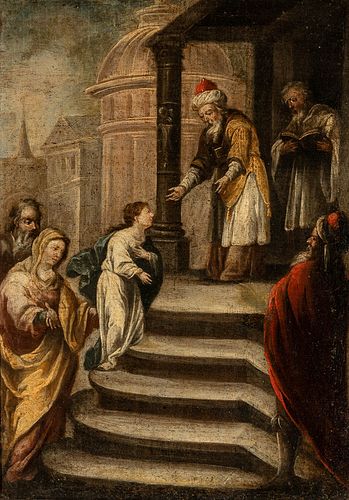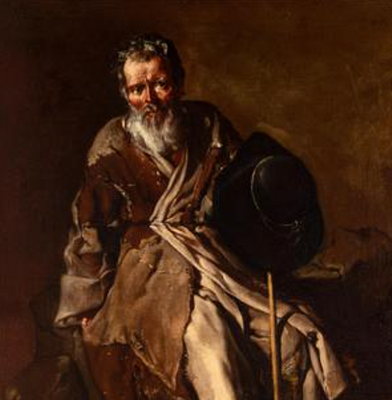Attributed to MATIAS DE ARTEAGA Y ALFARO (Villanueva de los Infantes, Ciudad Real, 1633 - Seville, 1703). "Presentation of the Virgin in the temple",
Lot 21
About Seller
Setdart Auction House
Carrer Aragó 346
Barcelona
Spain
Setdart Subastas was born in 2004 and is currently the first online art auction in Spain with solidity, prestige and reliability guaranteed by our more than 60,000 users. Setdart has a young, dynamic and enterprising team ready to successfully manage the purchase and sale of art works through custom...Read more
Estimate:
EUR€2,500 - EUR€3,000
$2,688.17 - $3,225.81
Absentee vs Live bid
Two ways to bid:
- Leave a max absentee bid and the platform will bid on your behalf up to your maximum bid during the live auction.
- Bid live during the auction and your bids will be submitted real-time to the auctioneer.
Bid Increments
| Price | Bid Increment |
|---|---|
| EUR€0 | EUR€10 |
| EUR€200 | EUR€25 |
| EUR€500 | EUR€50 |
| EUR€1,000 | EUR€100 |
| EUR€3,000 | EUR€200 |
| EUR€5,000 | EUR€500 |
| EUR€10,000 | EUR€1,000 |
| EUR€20,000 | EUR€2,000 |
| EUR€50,000 | EUR€5,000 |
About Auction
By Setdart Auction House
Jun 1, 2021
Set Reminder
2021-06-01 09:45:00
2021-06-01 09:45:00
America/New_York
Bidsquare
Bidsquare : OLD MASTERS & SCULPTURE - Day 2
https://www.bidsquare.com/auctions/setdart-auction-house/old-masters-sculpture---day-2-6999
Setdart Auction House sofia@setdart.com
Setdart Auction House sofia@setdart.com
- Lot Description
Attributed to MATIAS DE ARTEAGA Y ALFARO (Villanueva de los Infantes, Ciudad Real, 1633 - Seville, 1703). "Presentation of the Virgin in the temple", s. XVII. Oil on canvas. Measurements: 46 x 33 cm; 63 x 50 cm (frame). In this canvas the author represents a scene from the life of the Virgin Mary, her presentation in the Temple as a child. The narrative is set in an urban setting, dominated by a staircase that plays an important role in the story, and serves to differentiate the two planes of the composition, and at the same time to order the figures. These, starting from the foreground, establish a diagonal reading rhythm. The line starts from the head of St. Joachim in the lower left corner, goes up diagonally, passing by St. Anne, and guides our gaze to the Virgin, vividly illuminated, to finally reach the figure of Zachary, located at the top of the staircase. The canvas presents a scenographic composition, clearly counter-reformist. The scene is located on the outside of the temple, meticulously described, as befits baroque painting. It is worth mentioning that it was during the Baroque period when the representations of the virgin became more important and iconographically relevant because the Protestants did not believe in the figure of the virgin. Matías de Arteaga y Alfaro was a painter and engraver of the Spanish Baroque. Attached to the Sevillian school, he knew how to collect and interpret with his own personality the double influence of Murillo and Valdés Leal. Son of the engraver Bartolomé Arteaga, while still a child his family moved to Seville, where he would be trained in his father's workshop and in contact with Murillo, whose influence reveals his early work together with that of Valdés Leal, who settled in Seville the same year that Arteaga passed the master painter's exam, in 1656. In 1660 he was among the founding members of the famous drawing academy promoted by Murillo, among others, of which he served as secretary between that date and 1673. In 1664 he joined the Brotherhood of the Holy Charity and two years later in the Sacramental of the Sagrario of the Sevillian cathedral, for which he made some works. Around 1680 there is also evidence of his work as an appraiser of paintings. He died in 1703, the inventory of the goods left at his death reveals a well-to-do way of life, having a slave and a large and well-furnished house, which had a medium-sized library with important books in Latin and Spanish and an engraving studio, as well as more than one hundred and fifty paintings, almost half of them of religious subject matter. Among them were four series of the Life of the Virgin, some of which were expressly said to contain architectural views, such as those we see in this work and in those preserved in the Museum of Fine Arts in Seville. The most characteristic of his peculiar style are precisely these series of always religious subjects, set in broad landscapes and architectural perspectives taken from prints. Skillful in the creation of these deep perspectives, skillfully illuminated, however, in the treatment of the figures and their bodily expressions he tends to develop with a certain clumsiness. Arteaga is represented in the aforementioned museum in Seville, various Sevillian temples including the cathedral and the Lazaro Galdiano Museum, among others.
- Shipping Info
-
In-house shipping available. Please inquire at admin@setdart.com.
-
- Buyer's Premium



 EUR
EUR CAD
CAD AUD
AUD GBP
GBP MXN
MXN HKD
HKD CNY
CNY MYR
MYR SEK
SEK SGD
SGD CHF
CHF THB
THB














